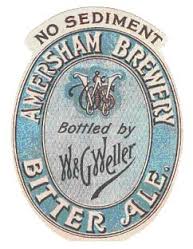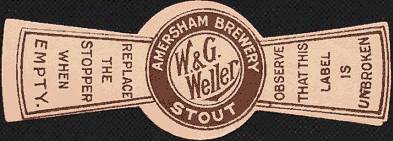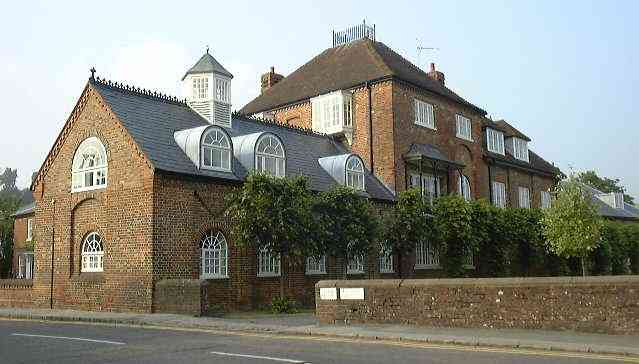
William left Wycombe, probably about 1776, for Amersham, where he had acquired the lease of the brewery next to the church, in Church Street, where it still stands though somewhat altered in appearance and no longer brewing.
The business flourished despite difficulties such as poor barley harvests in some years and William was able to buy several public houses in Amersham and surrounding villages and, in 1783, the Griffin malthouse. This building still exists though not as a malthouse.
When William died in 1802 he left the brewing business to two of his sons, John and William 2nd. His second son Thomas was not concerned with the brewery, having become a butcher in Penn where he lived with his wife Charlotte. They were my 3-greats-grandparents [Barbara Taylor] and I will return to them later.
When William Weller died in 1802, the brewery was left jointly to his sons John (1759-1843) and William [2] (1764-1843). The two brothers came into their inheritance at a Crucial moment. Nationally the years 1797 and 1801 had been bad for the brewing industry (The Transformation of England, by Peter Mathias, (Methuen, 1979), p.231), and the relatively small size of the Amersham, business must have made it precarious financially. Although there is no direst evidence of the level of production at the Church Street Brewery at this time, it is interesting to note from the surviving documentation relating to charitable donations that the Wellers were still not considered sufficiently well established to figure prominently in subscription lists. As the family had not yet diversified into parallel business activities such as farming, all their capital must have been bound up in the brewery with the result that investment potential was severely curtailed.
Nevertheless, there is evidence that the two brothers bought extra capital into the enterprise - possibly through advantageous marriages - for they immediately embarked on an extensive expansion programme that was to be sustained throughout the nineteenth century. One of the main problems encountered by local brewers such as the Wellers was how to extend their market. During the eighteenth century we can be certain that the majority of the brewery's sales were derived from purchases made by individuals and local publicans. However John and William[2] apparently realised that by extending the tied-property they would be able to increase production without recourse to middlemen. It is significant that within a few months of their fathers death they had almost doubled the tied estate by purchasing the 'Chequers', Amersham; the 'Red Lion' (previously the 'Red Sun'), Coleshill; the 'Queen's Head', Whielden Lane, Amersham; and the 'Red Lion', Penn (Conveyance, 23 March 1909).
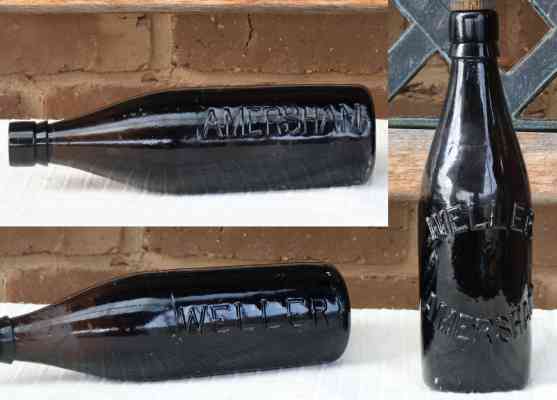
John and William expanded the business, purchasing more public houses and building the stables and coach houses opposite the brewery- still there, not much altered. In 1818 they were able to buy the brewery and its outbuildings and some land on which to build new larger maltings, with a water-wheel. About this time the brewery buildings were refaced with brick.
Attention was next turned to extending the brewery premises. On 29 December 1810 they purchased little Pondwicks and various cottages from John Sergeant to serve as drayman's accommodation, and two years later, on 12 January 1812, purchased the plot of land opposite the brewery from the reverend Jon Drake. The latter piece of land was used to build the stables and carpenters shop still to be seen lining the cobbled yard opposite the main brewery. Six years later John and William[2] finally entered into negotiations with George Hunt to purchase the Church Street Brewery outright. Agreement was finally reached on 28 November 1818, on which date the brewery and all it's outbuildings came into their sole possession. On the same day they also purchased Barn Meadow (the present recreation ground). This development was completed when the new maltings, complete with water wheel, were built in Barn Meadow and the brewery completely refaced with brick (Reflections of Amersham, by Jean Archer, (undated), p.24).
Following the second redevelopment of the brewery a second impressive phase of tied-property acquisition was entered into. This began in 1819 with the purchase of the Shoulder of Mutton, Monks Risborough, followed by; the Pheasant, Chalfont St. Peter (1822); the White Lion, Great Missenden (1822), the Wheatsheaf, Oakley (1823); the Blue Ball Ashridge (1824); the Cricketers, Harefield, Middlesex (1824); the Red Lion, Chenies; (1830); the Green Man, Aylesbury (1832); the Leather Bottle, Wendover (1832); the Barley Corn, Bledlow (1836); the Plume of Feathers, Aylesbury (1837); the Red Lion, Amersham (1837); the Eagle, Amersham (1838); the Windmill, Chipperfield (1841); the Squirrel, Penn Street (1841) and the Wheatsheaf, Amersham (1842). In 1838 the Wellers also diversified their business interest for the first time when they purchased Woodside farm, Amersham Common (Conveyance, 23 March 1909).
When John and William 2nd. died the business passed to John's son Edward, who died at Turnham Green and was buried at Amersham in the family plot beside the church, and William's son William 3rd. After his death his sons William, Edward and George carried on the business which by this time had become the largest employer of labour in the town, with half the workforce in its employ. The Wellers were generally considered to be good employers; their employees occupied tied cottages at modest rents and if a man died his widow was allowed to remain, when many employers would have turned them out immediately. At Christmas the men were given large joints of beef- 6lbs. for a single man, 8lbs. if married, or the equivalent in pork or mutton. George gave half a barrel of ale to the poor, his wife added tea, sugar, plum cake and tobacco.
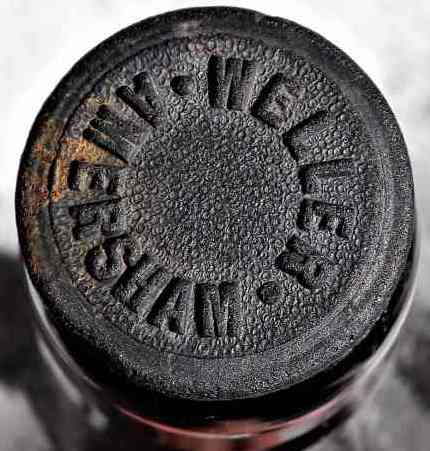
When Edward died, aged only 46, George bought his share from his widow, Edith. Edward had moved with his family to Brighton but still managed the farms at Amersham for a few years until his untimely death from pneumonia.
In 1900 George's son Gerard Masterman Heath Weller was taken into partnership with his father and Uncle William, but after William died in 1908 George purchased his share from his widow for £60,660 14s.5d. and at the same time bought Gerard out, Gerard then being employed as manager. George continued to run the business for another ten years or so, until he was about 75, and Gerard carried on until 1928. By then he was tired of the responsibility, saying he had not been away from his job for more than a week in 29 years. His father, though in poor health, resisted the idea of selling the business but Gerard obtained a court order to force the sale, which took place by auction in September 1929. The sale was a great blow to the people of Amersham, as it created so much unemployment, but there was no one to take Gerard's place. It had been hoped that Benskins, who bought the brewery, would keep it in operation as a bottling plant but they did not do so. The Wellers did what they could to soften the blow - with his final week's wages each man received an extra £1 for each year of service. With an average day's pay, being 3 shillings this was quite generous. They also had the option to buy their cottages.
George died on October 20th 1929 and was buried in the cemetery with his wife.
[Barbara Taylor]
